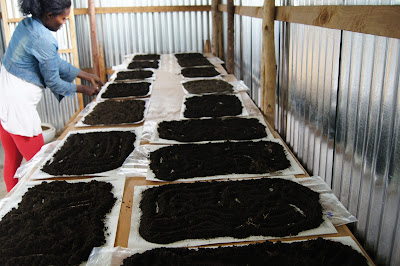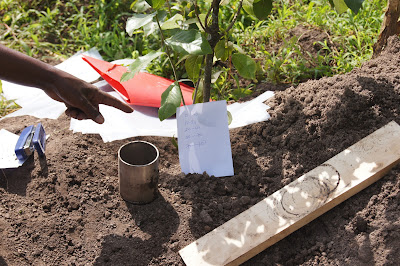- Rivest, D., Lorente, M., Olivier, A., Messier, C., 2013. Soil biochemical properties and microbial resilience in agroforestry systems: Effects on wheat growth under controlled drought and flooding conditions. Sci. Total Environ. 463-464, 51-60.
Abstract
Agroforestry is increasingly viewed as an effective means of maintaining or even increasing crop and tree productivity under climate change while promoting other ecosystem functions and services. This study focused on soil biochemical properties and resilience following disturbance within agroforestry and conventional agricultural systems and aimed to determine whether soil differences in terms of these biochemical properties and resilience would subsequently affect crop productivity under extreme soil water conditions. Two research sites that had been established on agricultural land were selected for this study. The first site included an 18-year-old windbreak, while the second site consisted in an 8-year-old tree-based intercropping system. In each site, soil samples were used for the determination of soil nutrient availability, microbial dynamics and microbial resilience to different wetting–drying perturbations and for a greenhouse pot experiment with wheat. Drying and flooding were selected as water stress treatments and compared to a control. These treatments were initiated at the beginning of the wheat anthesis period and maintained over 10 days. Trees contributed to increase soil nutrient pools, as evidenced by the higher extractable-P (both sites), and the higher total N and mineralizable N (tree-based intercropping site) found in the agroforestry compared to the conventional agricultural system. Metabolic quotient (qCO2) was lower in the agroforestry than in the conventional agricultural system, suggesting higher microbial substrate use efficiency in agroforestry systems. Microbial resilience was higher in the agroforestry soils compared to soils from the conventional agricultural system (windbreak site only). At the windbreak site, wheat growing in soils from agroforestry system exhibited higher aboveground biomass and number of grains per spike than in conventional agricultural system soils in the three water stress treatments. At the tree-based intercropping site, higher wheat biomass, grain yield and number of grains per spike were observed in agroforestry than in conventional agricultural system soils, but in the drought treatment only. Drought (windbreak site) and flooding (both sites) treatments significantly reduced wheat yield and 1000-grain weight in both types of system. Relationships between soil biochemical properties and soil microbial resilience or wheat productivity were strongly dependent on site. This study suggests that agroforestry systems may have a positive effect on soil biochemical properties and microbial resilience, which could operate positively on crop productivity and tolerance to severe water stress.Keywords
- Agroecosystems;
- Soil nutrients;
- Soil resilience;
- Soil respirometry;
- Water stress;
- Wheat growth
Ethiopian home gardens are sustainable traditional agroforesty systems that grow crops such as ensete (Ensete ventricosum) and coffee (Coffea arabica) that can coexist with various tree species to provide households with food, fuel and cash income, while protecting the soil and biodiversity. They can also enhance resilience to drought and contribute to mitigating climate change by enhancing soil carbon (C) sequestration.

Monday, June 24, 2013
Relevant literature
Tuesday, June 18, 2013
Related literature
Noponen, M.R.A., Healey, J.R., Soto, G., Haggar, J.P., 2013. Sink or source-The potential of coffee agroforestry systems to sequester atmospheric CO2 into soil organic carbon. Agriculture, Ecosystems & Environment 175, 60-68.
Highlights
- •
- SOC stocks decreased by 12.4% in Costa Rica and 0.13% in Nicaragua after establishment of coffee AFS.
- •
- SOC stocks increased in the top 10 cm of soil; greater reduction occurred at 20–40 cm.
- •
- Organic management caused a greater increase in 0–10 cm SOC but did not influence reduction at depth.
- •
- Shade type effects on SOC were smaller; no significant difference between shaded and unshaded coffee.
- •
- SOC stocks tend to converge on a level determined by site environment during establishment.
Abstract
Current carbon accounting methodologies often assume interactions between above-ground and below-ground carbon, without considering effects of land management. We used data from two long-term coffee agroforestry experiments in Costa Rica and Nicaragua to assess the effect on total soil organic carbon (SOC) stocks of (i) organic versus conventional management, (ii) higher versus moderate agronomic inputs, (iii) tree shade types. During the first nine years of coffee establishment total 0–40 cm depth SOC stocks decreased by 12.4% in Costa Rica and 0.13% in Nicaragua. Change in SOC differed consistently amongst soil layers: at 0–10 cm SOC stocks increased by 2.14 and 1.26 Mg C ha−1 in Costa Rica and Nicaragua respectively; however much greater reduction occurred at 20–40 cm (9.65 and 2.85 Mg C ha−1 respectively). Organic management caused a greater increase in 0–10 cm SOC but did not influence its reduction at depth. Effects of shade type were smaller, though heavily pruned legume shade trees produced a greater increase in 0–10 cm SOC than unpruned timber trees. No significant differences in SOC stocks were found between shaded and unshaded systems at any depth and SOC was poorly correlated with above-ground biomass stocks highlighting poor validity of “expansion factors” currently used to estimate SOC. SOC stock changes were significantly negatively correlated with initial SOC stock per plot, providing evidence that during establishment of these woody-plant-dominated agricultural systems SOC stocks tend to converge towards a new equilibrium as a function of the change in the quantity and distribution of organic inputs. Therefore it cannot be assumed that tree-based agricultural systems necessarily lead to increases in soil C stocks. While high inputs of organic fertiliser/tree pruning mulch increased surface-layer SOC stocks, this did not affect stocks in deeper soil, where decreases generally exceeded any gains in surface soil. Therefore site- and system-specific sampling is essential to draw meaningful conclusions for climate change mitigation strategies.
Friday, June 14, 2013
Saturday, June 1, 2013
Subscribe to:
Comments (Atom)















